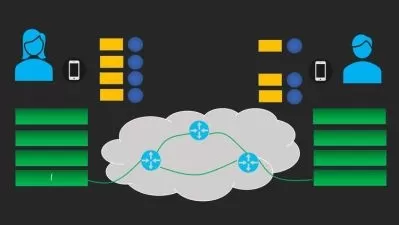Antenna Arrays for Radar and Communications
Georgy Moshkin
1:59:57
Description
Antennas Made Easy: A Simple step-by-step guide to design of planar antenna arrays
What You'll Learn?
- Choose antenna element dimensions
- Design array with parallel or series feeding
- Implement weighted amplitude distribution
- Calculate beamforming angle from antenna dimensions
- Design slotted waveguide antenna array
- Design mushroom-type metamaterial antenna
Who is this for?
What You Need to Know?
More details
DescriptionSimple step-by-step instructions will help you to design antenna arrays with series feeding and parallel feeding networks. You will learn how to "read" electromagnetic field distribution results; you will find out how to calculate radiation pattern and beamforming angle using simple formulas. Moreover, this course includes short introduction to common antenna array configurations that are often used in real radars and communication systems. At the end of this course, you will find practical instructions on slotted waveguide array design and metamaterial antenna design. It's time to replace patch elements with something more robust and wideband. Extremely compact, distilled, with multiple antenna simulation examples using openEMS - a free electromagnetic field solver.
First three lessons - the basics!
In lesson 1 you will learn how to design series-fed arrays with uniform power distribution. Full procedure and simulation example for weighted series arrays available in lesson 6. Lesson 2 shows how to design shunt-fed patch arrays. Lesson 3 reuses inset-fed patch element from lesson 2 to build a parallel-fed antenna array.
Each simulation includes electromagnetic field distribution graph, which is explained in lesson 4.
Lessons 5 and 7 explain radiation pattern and beamforming. These two lessons share common formulas and concepts, such as wavefront. Lesson 6 in-between describes antenna element weighting technique that can be used to reduce side lobe levels at the cost of increased beamwidth.
From the Lesson 8 you will learn how to solve some of the challenges you may face during array design process.
Lesson 9 is a brief introduction to common antenna array configurations.
Additionally, lessons 10 and 11 provide design steps required for slotted waveguide and simple metamaterial antenna design.
This course includes unique example scripts to perform openEMS simulations for all common array antenna configurations (in-line series, shunt-fed and parallel feeding) with routines that output beautiful EM field distribution graphs directly using Octave. No need to export data to other software!
While running openEMS simulations feels a little difficult compared to HFSS or CST Microwave Studio, openEMS is absolutely free, open source and has an active GitHub discussion forum.
If you have any difficulties with understanding provided concepts and design steps - simply ask me a question! I'll try my best to update this course with answers to all your questions on antenna design!
Who this course is for:
- Engineers who need simple practical instructions on how to design array antennas
- Students who need more practical examples to back up their theoretical knowledge and remove any doubts
- Researchers and Educators who need some starting point to do their work faster
Simple step-by-step instructions will help you to design antenna arrays with series feeding and parallel feeding networks. You will learn how to "read" electromagnetic field distribution results; you will find out how to calculate radiation pattern and beamforming angle using simple formulas. Moreover, this course includes short introduction to common antenna array configurations that are often used in real radars and communication systems. At the end of this course, you will find practical instructions on slotted waveguide array design and metamaterial antenna design. It's time to replace patch elements with something more robust and wideband. Extremely compact, distilled, with multiple antenna simulation examples using openEMS - a free electromagnetic field solver.
First three lessons - the basics!
In lesson 1 you will learn how to design series-fed arrays with uniform power distribution. Full procedure and simulation example for weighted series arrays available in lesson 6. Lesson 2 shows how to design shunt-fed patch arrays. Lesson 3 reuses inset-fed patch element from lesson 2 to build a parallel-fed antenna array.
Each simulation includes electromagnetic field distribution graph, which is explained in lesson 4.
Lessons 5 and 7 explain radiation pattern and beamforming. These two lessons share common formulas and concepts, such as wavefront. Lesson 6 in-between describes antenna element weighting technique that can be used to reduce side lobe levels at the cost of increased beamwidth.
From the Lesson 8 you will learn how to solve some of the challenges you may face during array design process.
Lesson 9 is a brief introduction to common antenna array configurations.
Additionally, lessons 10 and 11 provide design steps required for slotted waveguide and simple metamaterial antenna design.
This course includes unique example scripts to perform openEMS simulations for all common array antenna configurations (in-line series, shunt-fed and parallel feeding) with routines that output beautiful EM field distribution graphs directly using Octave. No need to export data to other software!
While running openEMS simulations feels a little difficult compared to HFSS or CST Microwave Studio, openEMS is absolutely free, open source and has an active GitHub discussion forum.
If you have any difficulties with understanding provided concepts and design steps - simply ask me a question! I'll try my best to update this course with answers to all your questions on antenna design!
Who this course is for:
- Engineers who need simple practical instructions on how to design array antennas
- Students who need more practical examples to back up their theoretical knowledge and remove any doubts
- Researchers and Educators who need some starting point to do their work faster
User Reviews
Rating
Georgy Moshkin
Instructor's Courses
Udemy
View courses Udemy- language english
- Training sessions 60
- duration 1:59:57
- Release Date 2024/08/11










